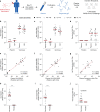Passive transfer of Ad26.COV2.S-elicited IgG from humans attenuates SARS-CoV-2 disease in hamsters
- PMID: 35013325
- PMCID: PMC8748674
- DOI: 10.1038/s41541-021-00427-z
Passive transfer of Ad26.COV2.S-elicited IgG from humans attenuates SARS-CoV-2 disease in hamsters
Abstract
SARS-CoV-2 Spike-specific binding and neutralizing antibodies, elicited either by natural infection or vaccination, have emerged as potential correlates of protection. An important question, however, is whether vaccine-elicited antibodies in humans provide direct, functional protection from SARS-CoV-2 infection and disease. In this study, we explored directly the protective efficacy of human antibodies elicited by Ad26.COV2.S vaccination by adoptive transfer studies. IgG from plasma of Ad26.COV2.S vaccinated individuals was purified and transferred into naïve golden Syrian hamster recipients, followed by intra-nasal challenge of the hamsters with SARS-CoV-2. IgG purified from Ad26.COV2.S-vaccinated individuals provided dose-dependent protection in the recipient hamsters from weight loss following challenge. In contrast, IgG purified from placebo recipients provided no protection in this adoptive transfer model. Attenuation of weight loss correlated with binding and neutralizing antibody titers of the passively transferred IgG. This study suggests that Ad26.COV2.S-elicited antibodies in humans are mechanistically involved in protection against SARS-CoV-2.
© 2022. The Author(s).
Conflict of interest statement
D.H.B., R.C.Z., F.W. and H.S. are co-inventors on provisional vaccine patents (63/121,482; 63/133,969; 63/135,182). F.C., J.T.B.M.T., A.Md.G., D.H., M.L.G., J.S., F.W., R.C.Z., H.S. are employees of Janssen Vaccines & Prevention BV and may hold stock in Johnson & Johnson.
Figures



References
Grants and funding
LinkOut - more resources
Full Text Sources
Other Literature Sources
Miscellaneous

